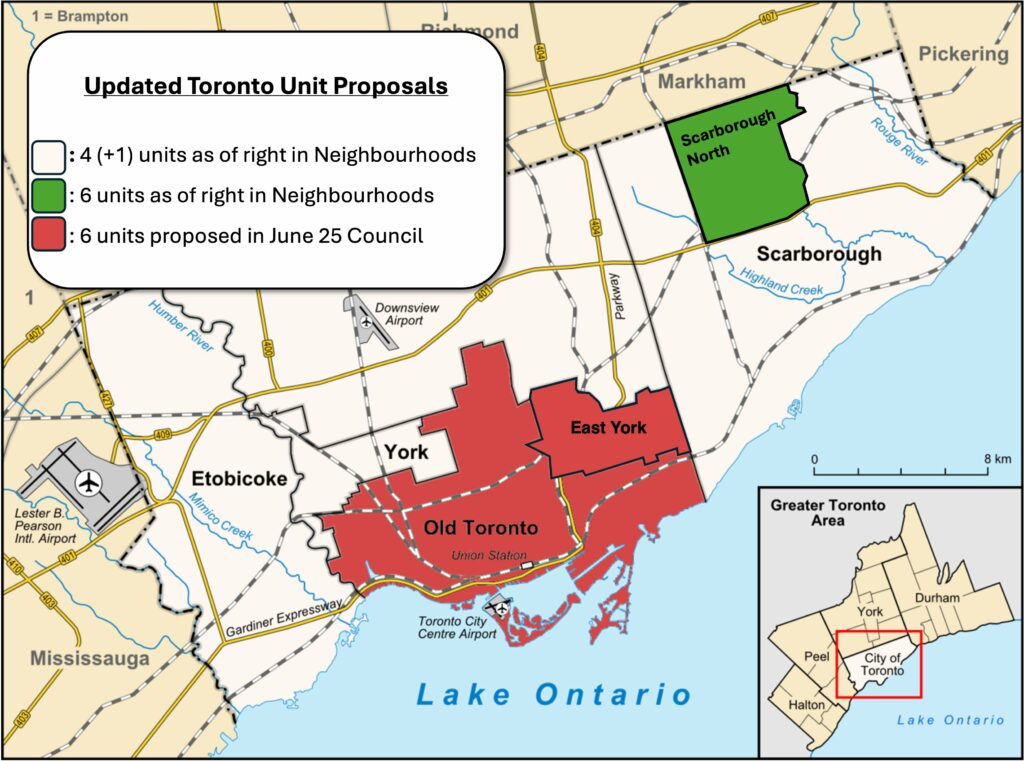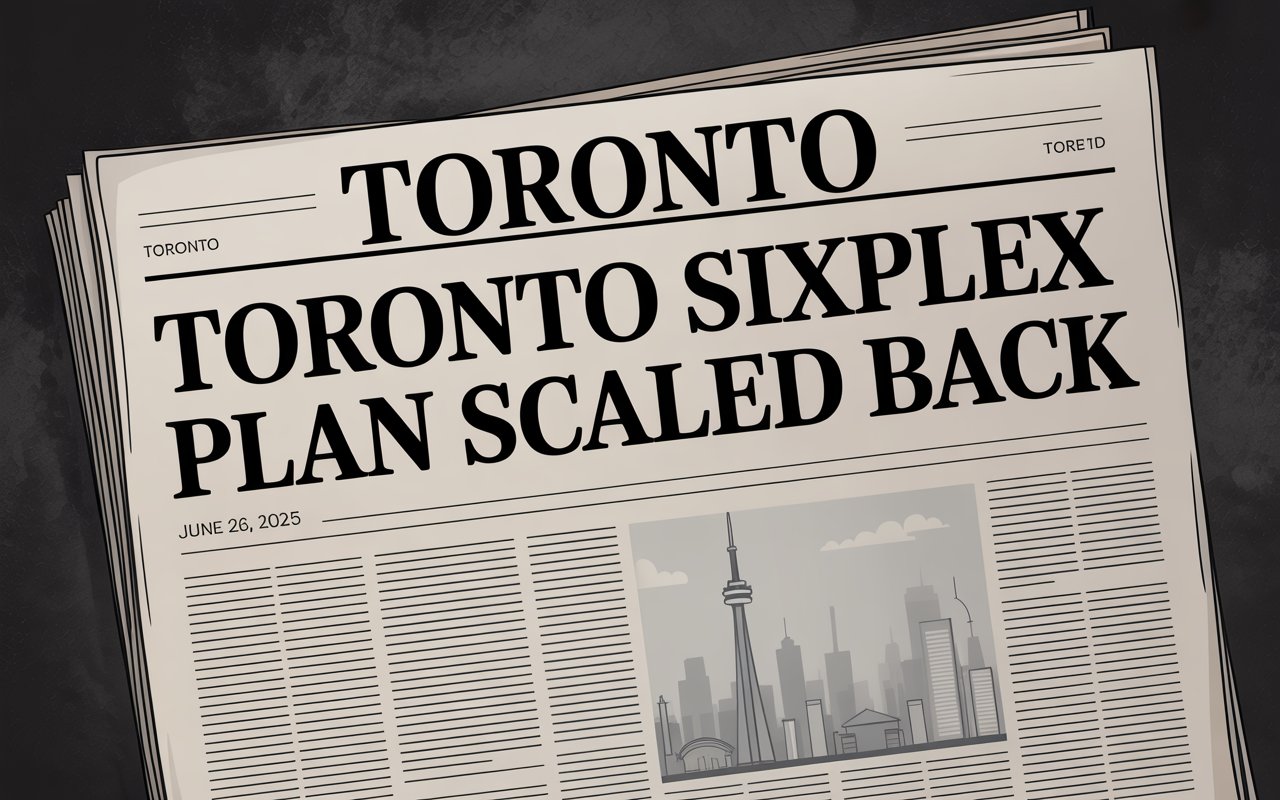Table of Contents
After months of momentum toward opening Toronto’s housing market to denser, low-rise development, city council hit the brakes. What was supposed to be a citywide legalization of sixplexes, small apartment buildings with six units, was scaled back to just nine wards. The decision reflects a familiar pattern in Toronto politics: incrementalism in the face of a crisis.
Let’s break down what happened, and what it means.
What Was Toronto Trying to Do?
In simple terms, Toronto was planning to allow property owners across the city to build six-unit homes without needing special permission. The idea was to expand on its 2023 “multiplex” policy, which already allows up to four units on most residential lots.
This shift is about more than just sixplexes. It’s about reforming zoning laws that have historically banned anything other than detached and semi-detached homes in most of Toronto. It’s about bringing back a “missing middle” of housing, something more spacious than a condo, but more affordable than a detached house.
Where Are Sixplexes Actually Allowed?
To visualize the decision, take a look at the map below, which shows where six-unit buildings are currently permitted and where council approved the expansion as of June 25:
- Green: Scarborough North — part of an earlier pilot project where sixplexes were already legalized
- Red: Old Toronto and East York — newly approved zones for sixplexes under the June 25 council motion
- White: Areas still limited to 4 (+1) units, unless councillors opt in later

Why Did the Council Pull Back?
Because they couldn’t agree. Some councillors, especially those in the inner suburbs, said the move was rushed. They wanted more time, more studies, and more assurance that neighbourhoods could absorb the change.
Councillor Gord Perks, who has championed the idea of expanding housing density, admitted he was “heartbroken.” His compromise: legalize sixplexes only in old Toronto, East York, and part of Scarborough where a pilot project had already begun.
The motion passed 18–6. It wasn’t the sweeping reform staff had proposed, but it was something. And in today’s politics, “something” often means survival.
What’s at Stake?
Plenty. For one, $471 million in federal housing funds is tied to this policy shift. The city has already received part of that funding, but it risks losing a quarter of its annual installments if it doesn’t follow through on its promises.
More importantly, the decision tests whether Toronto is truly serious about solving its housing crisis or simply managing it.
Is Opposition to Sixplexes Valid?
It’s easy to dismiss the critics as NIMBYs (Not In My Back Yard), but that would be reductive. Many residents are genuinely concerned about parking, infrastructure, and the pace of change. And yes, those issues matter.
But they’re also often overstated. A city staff report said sixplexes would result in only minor increases in sewer usage and traffic. Meanwhile, cities like Minneapolis and Portland, which have already introduced similar reforms, haven’t collapsed under the weight of small apartment buildings.
What Does This Mean for Renters and Investors?
For renters, this shift, though modest, is a sign of progress. The sixplex framework introduces more mid-sized rental units into neighbourhoods where rental supply is scarce. These homes could be larger, family-friendly, and located in areas typically dominated by single-family ownership. That’s crucial in a city where condos dominate the rental stock and affordability remains elusive.
For investors, the door just cracked open on a new asset class. Sixplexes offer a unique opportunity to generate steady income on lots previously limited to one or two units. With proper design, they can be optimized for multi-generational tenants, co-living arrangements, or boutique rental offerings. And with the federal funding attached, there’s a strong policy tailwind behind any ward that opts in later.
However, the patchwork rollout means smart investors will need to pay close attention to zoning updates and local politics. Not every ward will move at the same speed and that lag could create pricing differentials (and opportunities) in the short term.
Why Does This Matter?
Because Toronto has run out of room to sprawl. We can’t build out. We must build in.
Allowing sixplexes is one of the least disruptive, most cost-effective ways to add housing in a city where demand constantly outstrips supply. It provides options for multigenerational families, downsizing seniors, and middle-income renters who can’t find anything between a luxury tower and a basement suite.
If we keep defaulting to detached homes on 30-foot lots, we’re preserving the problem, instead of solving it.
So, What Happens Now?
For now, sixplexes will be allowed in nine of the city’s 25 wards. Other councillors can opt in later. Mayor Olivia Chow called it “a path forward,” suggesting that once people see the benefits, more neighbourhoods will follow.
That’s a hopeful view, and perhaps an accurate one. But progress shouldn’t rely on political moods. It should be led by data, demand, and the moral imperative to house people fairly and affordably.
Final Thought: Is Caution Killing Ambition?
Toronto is not a city short on plans. It is, however, short on action. Every delay has a cost, measured not in dollars, but in lives put on hold, families squeezed into basements, and workers priced out of the communities they serve.
Allowing sixplexes citywide wouldn’t solve everything. But it would send a powerful message: that Toronto is willing to evolve. That it’s willing to change not just in spirit, but in form.
This week, the council took a step forward, but not a leap. And in a city running out of time, that may not be enough.
Looking for sixplex-ready lots or existing multi-unit homes?
Browse properties in Toronto’s newly approved sixplex zones, before more wards opt in.
Start your search with Valery today.
